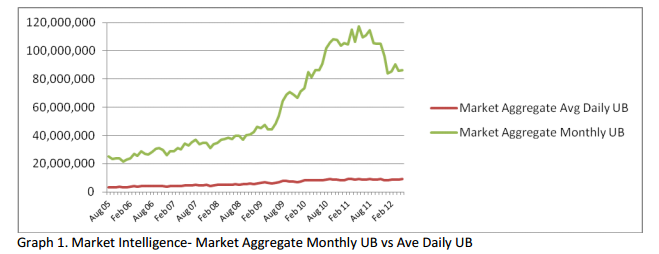In a press release today, online advertising industry body the Interactive Advertising Bureau (IAB) has announced it no longer feels unique browsers is a reliable metric for online traffic.
IAB Australia has issued a Notice of Intent to the industry advising it is retiring the Monthly Unique Browser (UB) metric in Australia as of 1st February 2013. Following that date, IAB has advised the Monthly UB metric should not be used as an audience proxy and in line with this move Nielsen will stop reporting this metric within its Market Intelligence product.
Instead, the use of a people-based metric Unique Audience (UA) should be used. The Monthly UB metric is being retired as it is no longer in line with the active online population or even total population. Monthly UBs now total over 90 million in Australia – outnumbering the actual human online population by a factor of more than five. The decision to retire the metric was made by the IAB Measurement Council with the MFA and has the support of AANA.
Gai Le Roy, IAB Australia’s Director of Research, commented: “The Monthly UB metric has been used in the Australian market for more than 15 years but now that it no longer equals a person, it has outlived its usefulness as a proxy for monthly visitation to website figures and should not be used.”
“As an industry we are looking for more accurate and meaningful data and it’s clear that the Monthly UB metric is become increasingly inaccurate, less useful and even misleading. Indeed with the proliferation of devices and browsers in use by consumers, the disparity between browsers and actual people will only accelerate,” said Le Roy.
While the Monthly UB metric is being retired, the Average Daily UB metric may still be used as the IAB Measurement Council has determined that the active online population in Australia is aligned with the Average Daily UB numbers.
In conducting its review, the Measurement Council found that while the Monthly Unique Browsers inflation is most noticeable at a Market Aggregate level, the top five Publishers in Nielsen’s Market Intelligence (MI) often have a greater number of Monthly Unique Browsers than total Australian Active Online universe of 16.1 million people – an impossible and implausible amount.
Source: IAB press release
IAB say the reason behind this is because:
The massive growth in Monthly Unique Browsers from just over 25 million in 2005 to 90 million in 2012. Clearly such a ‘user level’ is not possible in a country with a total population of just over 22 million people and with recent estimates of the Australian Active Online Universe being just over 16 million. However, pleasingly it can be noted that the Average Daily Unique Browsers is both at a level below that of the population and reflecting a plausible growth.

The research found that in 2000, the main locations for accessing the internet were home and/or work using a PC or laptop. People typically used one browser on each machine so if a person accessed from home and from work they would generate 2 browsers cookies.
However in 2012, we now have on average 1.4 laptops per household and 1.7 desktops. 90% of people have accessed the internet from home, with 57% of people having accessed from work. However, now in addition to home and work we also see that 55% of the online population have accessed from a mobile, 20% from a tablet, 18% from a games console and 11% from a TV. (Sources: ownership from Nielsen CMV, usage from Nielsen online consumer report)
Further to this, a user typically doesn’t generate just one cookie per device. Instead they often generate multiple cookies, particularly as users now tend to have more than one browser and are tending to clear out their browsers more frequently which generates new cookies. The nett effect is that a single user now typically generates many cookies across multiple devices and browsers, and the longer the time period the more the cookie duplication happens (which is why Monthly Unique Browsers are affected more than Average Daily Unique Browsers).
See the IAB’s FAQs document on why they have announced monthly UB as an unreliable metric here



